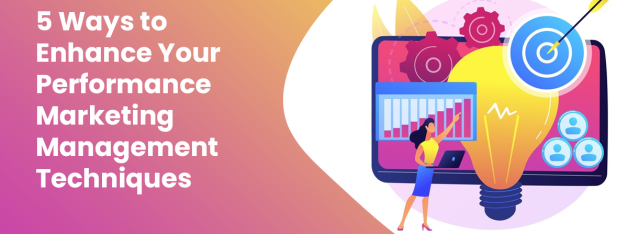5 Ways to Improve Your Performance Marketing Management Techniques

Performance marketing has changed the face of advertising because it is now all about measurable results, such as more website traffic, higher conversion rates, and engaged audiences. However, managing performance marketing is not just about running campaigns; it needs strategy, precision, and continuous optimization.
We will be discussing five high-performance techniques to elevate performance marketing management so that the efforts pay and work for the real audience. Let’s begin by discussing them in brief.
1. Optimize landing pages for maximum conversions
A landing page is the first impression of your brand for potential customers. A poorly designed or confusing landing page can derail even the best marketing campaign. To ensure that your campaigns deliver results, focus on optimizing your landing pages for usability and impact.
Best Practices for Landing Pages:
- Clear Call-to-Action (CTA): Your CTA must stand out and directly communicate the desired action.
- Mobile Responsiveness: with mobile traffic driving the majority, responsive designs are a no-brainer.
- Speed Matters: Pages under three seconds have had dramatically lower bounce rates.
Example: A fitness app optimized its landing page, using compelling visuals and simplifying the navigation process. Conversions were up 35%.
Pro Tip: Use A/B testing to try out headlines, CTAs, and layouts, then refine pages based on data.
2. Use Real-Time Analytics for Continuous Optimization
Performance marketing lives and dies by data. Real-time analytics allow you to track campaigns in real time, making adjustments on the fly and avoiding wasted spend.
How Real-Time Analytics Help:
- Identify underperforming ads and reallocate budgets.
- Adjust targeting to refine your marketing funnel.
- Optimize bids to improve ROI.
Example: An e-commerce brand used real-time insights to identify peak engagement hours on social media, adjusting posting schedules to maximize audience reach.
Pro Tip: Use Google Analytics and HubSpot, among other tools, to keep a tab on real-time performance across all channels.
3. Tap into Social Media to Drive Engagement
Social media networks are incredibly handy for performance marketing given the immense reach and targeting potential the networks afford. Contact with targeted segments of the audience on Instagram, Facebook, and LinkedIn will be able to create buzz and deliver conversions.
Best Social Media Marketing Practices
- Run a carousel ad to showcase multiple products or services.
- Retargeting ads: Re-engage the users who failed to convert at the first go.
- Influencer marketing: Amplify your message.
Example: Food delivery service had run localized Facebook ads with limited-period offers, and they eventually transferred more downloads of their app by 25%.
Pro Tip: Engage in periodical assessment of engagement metrics such as shares, comments, and click-through rates for further amplifications.
4. Optimizing Your Marketing Funnel
A good marketing funnel is going to be helping support potential customers in conversion with minimal effort, and performance marketing is all about optimizing every part of the funnel so that frictions are reduced, and more results are gained.
Stages of the Funnel include:
- Awareness: Include more content like a blog, videos, and social posts that attract the target customer.
- Consideration: Engage your potential leads by offering free trials, demos, or even webinars.
- Conversion: Simplify checkout and retarget to sale.
Case study: A SaaS company improved its funnel by including personalized follow-up emails in the consideration stage. This resulted in a 20% increase in conversion.
Pro Tip: Sync your funnel strategy to know about the pain point of the customer to make it more personalized.
5. Targeted Customer Personalization Campaigns
Generic campaigns rarely work in the current competitive scenario. Targeting your marketing approaches to specific customer needs will guarantee higher engagement and results.
How to Personalize Campaigns:
- Segment your target audience by demographics, behavior, or preferences.
- Dynamic ad creatives based on individual user profiles
- Personalize email subject lines and content for higher open rates
Example: A travel agency personalized ads based on user browsing history, showing destination-specific deals and increasing bookings by 40%.
Pro Tip: Utilize the capabilities of the machine learning tool to predict user behavior and create hyper-relevant campaigns.
FAQs On Performance Marketing Management
Q: How does performance marketing improve with real-time analytics?
A: Realtime gives marketers an opportunity to get a glimpse of the issues within the system and calibrate the targeting as well as the budget so that outcomes can improve
Q: What is the importance of a landing page for a campaign?
A: Landing pages are basically a conversion gateway. With a very good page, experience is enhanced and the desired actions increased.
Q: Which social media channel is best suited for performance marketing?
A: It depends on your target audience. Instagram is great for visual content, whereas LinkedIn is excellent for B2B campaigns.
Conclusion
Running ads is not what this performance marketing management does; it ensures every piece, from landing page to social media platforms, works in an end-to-end direction wherein results are measurable. Real-time analytics, refined marketing funnel, and campaigns that are aimed at the most desired customers help increase your conversion rates and drive long-term growth.
Prepare to take your performance marketing to the next level. Implement these strategies, and watch your outcome skyrocket into new heights from today forward.
